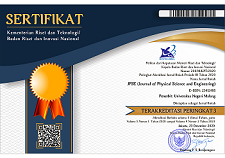Comparison of Microphysics Schemes on WRF-HAILCAST Model to Study Hailstone in Aeronautics (Case Study: Hail Strike on AirAsia A320-200, November 16, 2018)
Abstract
A hail strike is caused by the hail phenomenon, an aviation accident caused by environmental factors. Hail is a type of extreme weather in the form of precipitation ice grains which is generally caused by cumulonimbus clouds. Research on hail modeling can be carried out using the Weather Research Forecasting Hail Forecast (WRF-HAILCAST), which can model the structure, dynamics, microphysics, hailstone distribution, and estimate the maximum diameter of the hailstone. In this study, the hail modeling that caused the hail strike on the AirAsia A320-200 aircraft on November 16, 2018, was carried out using the WRF-HAILCAST model with six different microphysics schemes. This study compares the results of the microphysics scheme on the WRF-HAILCAST model in hail modeling. The results of this study indicated that each microphysics scheme produces a different outcome. Generally, the spatial and temporal distribution of the entire scheme could indicate the presence of convective clouds reaching 40–55 dBZ. Each scheme showed the microphysical processes of clouds consisting of different hydrometeor particles. However, only MY2 and NSSL showed the presence of supercooled water, and those schemes could estimate maximum diameter hailstone worth 25.8 mm and 13.2 mm. So, NSSL is the best microphysics scheme in this study.
Keywords
Full Text:
PDFReferences
A. Kristianto, I. J. A. Saragih, G. Larasati, and K. Akib, “Identifikasi kejadian hujan es menggunakan citra radar dan satelit cuaca,” Pros. PIT Ke-5 Ris. Kebencanaan Univ. Andalas, Padang, May 2–4, 2018, pp. 349–362.
L. Yin, F. Ping, and J. Mao, “Impact of cloud microphysical processes on the simulation of a hailstorm in East China,” Atmos. Res., vol. 219, pp. 36–56, May 2019, doi: 10.1016/j.atmosres.2018.12.014.
N. M. Sani and R. Gernowo, “Analisis turbulensi pada pesawat Etihad Airways EY-474 tanggal 4 Mei 2016 dengan metode weather research and forecasting,” Youngster Phys. J., vol. 7, no. 1, pp. 34–39, Jun. 2018.
J. R. Holton, An Introdution to Dynamic Meteorology, 4th ed. Burlington, MA, USA: Elsevier Academic Press, 2004.
M. D. Syaifullah, “Analisis kondisi udara atas wilayah Indonesia dengan data radiosonde” J. Meteorol. Geofis., vol. 18, no. 1, Nov. 2017, pp. 1–12, doi: 10.31172/jmg.v18i1.268.
J. Labriola, N. Snook, M. Xue, and K. W. Thomas, “Forecasting the 8 May 2017 severe hail storm in Denver, Colorado, at a convection-allowing resolution: Understanding rimed ice treatments in multimoment microphysics schemes and their effects on hail size forecasts,” Mon. Weather Rev., vol. 147, no. 8, pp. 3045–3068, Aug. 2019, doi: 10.1175/MWR-D-18-0319.1.
D. McCann and M. Aviation, “Forecasting hail aloft,” in 18th Conf. Aviat., Range, Aerosp. Meteorol., Seattle, Jan. 22–26, 2017, p. 212.
F. P. Sari, A. P. Baskoro, and O. S. Hakim, “Effect of different microphysics scheme on WRF model: A simulation of hail event study case in Surabaya, Indonesia,” in AIP Conf. Proc., vol. 1987, no. 1, p. 020002, Jul. 2018, doi: 10.1063/1.5047287.
R. D. Adams-Selin et al., “Evolution of WRF-HAILCAST during the 2014–16 NOAA/hazardous weather testbed spring forecasting experiments,” Weather Forecast., vol. 34, no. 1, pp. 61–79, Feb. 2019, doi: 10.1175/WAF-D-18-0024.1.
N. Ayasha, “Kajian analisis parameter vertical velocity dan kaitannya dengan kondisi parameter cuaca saat kejadian hujan es,” Bul. GAW Bariri, vol. 3, no. 1, pp. 17–24, Aug. 2022, doi: 10.31172/bgb.v3i1.64.
R. D. Adams-Selin and C. L. Ziegler, “Forecasting hail using a one-dimensional hail growth model within WRF,” Mon. Weather Rev., vol. 144, no. 12, pp. 4919–4939, Dec. 2016, doi: 10.1175/MWR-D-16-0027.1.
J. M. Wallace and P. V. Hobbs, Atmospheric Science: An Introductory Survey, 2nd ed. Burlington, MA, USA: Elsevier Academic Press, 2006.
K. E. Kunkel et al., “Monitoring and understanding trends in extreme storms: State of knowledge,” Bull. Am. Meteorol. Soc., vol. 94, no. 4, pp. 499–514, Apr. 2013, doi: 10.1175/BAMS-D-11-00262.1.
SELEX, Software Manual Rainbow 5 Product & Algorithms. Neuss, Germany: SELEX Sistemi Integrati GmbH, 2013.
B. H. K. Tjasyono, Klimatologi, 2nd ed. Bandung, Indonesia: ITB Press, 2004.
A. Khain, T. V. Prabha, N. Benmoshe, G. Pandithurai, and M. Ovchinnikov, “The mechanism of first raindrops formation in deep convective clouds,” J. Geophys. Res.: Atmos., vol. 118, no. 16, pp. 9123–9140, Jul. 2013, doi: 10.1002/jgrd.50641.
D. Martínez-Castro et al., “The impact of microphysics parameterization in the simulation of two convective rainfall events over the central Andes of Peru using WRF-ARW,” Atmos., vol. 10, no. 8, p. 442, Aug. 2019, doi: 10.3390/atmos10080442.
Badan Meteorologi Klimatologi dan Geofisika. (2010, Oct. 7). Peraturan Kepala Badan Meteorologi, Klimatologi, dan Geofisika Nomor: Kep. 009 Tahun 2010 Tentang Prosedur Standar Operasional Pelaksanaan Peringatan Dini, Pelaporan, dan Diseminasi Informasi Cuaca Ekstrim. [Online]. Available: https://peraturan.bpk.go.id/Home/Details/191418/perka-bmkg-no-kep9-tahun-2010
S. Zhang, S. Liu, and T. Zhang, “Analysis on the evolution and microphysical characteristics of two consecutive hailstorms in spring in Yunnan, China,” Atmos., vol. 12, no. 1, p. 63, Jan. 2021, doi: 10.3390/atmos12010063.
B. H. K. Tjasyono, Mikrofisika Awan dan Hujan. Jakarta, Indonesia: Badan Meteorologi, Klimatologi, dan Geofisika, 2012.
M. Frystine, A. Mulya, A. Kristianto, and M. P. Maulidyah, “Analysis of atmospheric condition on hail event at Pelalawan (Case study: September 23rd, 2019),” J. Meteorol. Geofis., vol. 23, no. 2, pp. 45–56, Jun. 2022, doi: 10.31172/jmg.v23i3.813.
Komite Nasional Kecelakaan Transportasi, “Laporan Statistik 2020.” knkt.go.id. http://knkt.go.id/post/read/buletin-knktedisi-januari---maret-2020 (accessed Jan. 22, 2022).
C. D. Ahrens and R. Henson, Meteorology Today: An Introduction to Weather, Climate and the Environment, 11th ed. Boston, MA, USA: Cengage Learning, 2015.
M. Karalis et al., “Effects of secondary ice processes on a stratocumulus to cumulus transition during a cold-air outbreak” Atmos. Res., vol. 277, p. 106302, Oct. 2022, doi: 10.1016/j.atmosres.2022.106302.
S. Hradecky, “Incident: Indonesia AirAsia A320-200 at Jogjakarta on Nov 16th 2018, hail strike.” The Aviation Herald. http://avherald.com/h?article=4c07f42a&opt=0 (accessed Jan. 15, 2022).
DOI: http://dx.doi.org/10.17977/um024v8i12023p020
Copyright (c) 2023 Muhammad Ikko Safrilda Maulana and Aries Kristianto

This work is licensed under a Creative Commons Attribution-ShareAlike 4.0 International License.
This work is licensed under a Creative Commons Attribution-ShareAlike 4.0 International License




















